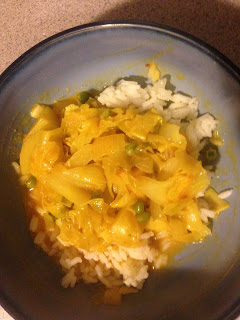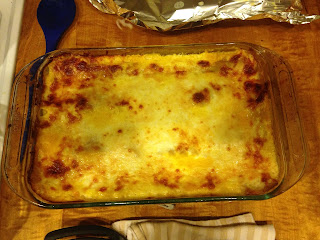It wasn't a stellar week of CSA utilization, but I've been doing my best to make up for it this weekend. I've been making
fajita salad, freezing peppers, experimenting with dehydrating radishes (post to come if results are positive), and making this - a warm, delicious, straightforward, coconut curry with vaguely Caribbean tendencies.
I had planned to make it with Madras curry powder, but I ended up picking up a jar of Jamaican curry powder (
this one) at Jungle Jim's yesterday. I like the idea that by altering the particular curry blend (I have used Madras, Thai red curry paste, and Jamaican in various dishes) I can "push" a dish towards a certain part of the world or culinary tradition. The differences between them are going to vary by brand if you're not making your own blends and of course a lot of brands don't reveal all the spices they contain. That being said, even though the first four spices (turmeric, coriander, fenugreek, and cumin) listed on the Jamaican and Madras ingredient labels are the same, I know that the former contains allspice, whereas the latter does not. If my nose had to guess the Jamaican doesn't have Asafoetida like the Madras, either. Thai curry paste is a totally different animal. The first ingredient in
mine is red chili pepper and it contains lemongrass, galangal, and kaffir lime. I also usually put a lot more of this one in a dish when seasoning it - I think the flavor is less concentrated. That being said, it would probably be equally delicious here used in the right proportions.
But let's be honest, it's really all about the coconut milk. Even without the curry
coconut milk can perform magic. Coconut milk seeps into every corner of every ingredient, giving everything a luxurious flavor and mouthfeel. The spice blend just puts things over the top. Plus, the "flavor profile" of coconut curry is so adaptable (see
here and
here - both Thai variations).
As we were eating, Jonathan remarked that this would be good with some jerk chicken. Then we both recalled that
our favorite Jamaican restaurant serves a couple of vaguely similar dishes - Mango Rundown Tofu/Salmon/Catfish/Shrimp, which has a similar flavor profile (though it's been awhile), and Mountain Boy Stir Fry, which is primarily cabbage, if I recall. Though this dish originally came from a site called, "My Columbian Recipes," I think I was on to something with the Jamaican thing.
Cabbage and Sweet Potato Coconut Curry
Adapted from here
Ingredients
- 3 tbsp. vegetable oil
- 1/2 tsp. crushed red pepper flakes, or more to taste
- 2 small-to-medium or 1 large onion
- 4 cloves garlic, minced
- 1/2 tsp ground cumin (I used pre-ground, fearing the freshly ground would be too intense for this)
- 1 1/2 - 2 tsp. curry powder (I used this, see above)
- 1 cup chicken or vegetable broth
- 1 13.5-oz (or so) can coconut milk
- 1/2 cup tomato sauce
- 1 tbsp. tomato paste
- 3/4 tsp. salt, or to taste (will depend on the saltiness of the tomato sauce, too), divided
- 2 large sweet potatoes (I used 4 CSA sweet potatoes), peeled and cubed
- 1 large white potato (I used 2 yukon golds), peeled and cubed
- 1 head cabbage shredded
- 1/2 cup shredded coconut
- 1-2 tbsp. lime juice, or to taste, from about 1/2 lime
- 1 cup frozen peas
Directions
- In a stock pot, heat the oil over medium heat.
- Add the onion and pepper flakes and cook, stirring occasionally, until the onions soften.
- Add the cabbage and cook, stirring occasionally, until the cabbage collapses and maybe even takes on some color.
- Add the sweet and white potatoes, mix, and cook a few more minutes.
- Add the garlic, cumin, and curry, and cook about 1 minute, until fragrant.
- Add the broth, coconut milk, and tomato sauce, tomato paste, and 1/2 tsp. salt. Bring to a boil, then reduce to medium-low.
- Add the shredded coconut, then cover and cook about 30 minutes, until potatoes are tender.
- Once the curry has been simmering about 10 or 15 minutes taste and add more salt if needed, I added another 1/4 tsp. during simmering.
- When potatoes are cooked uncover and stir in the peas and 1 tbsp. lime juice. Taste and add more salt and lime if needed. I added another 1/2 tbsp. lime.
- Grind or sprinkle with a little extra salt when serving, if desired.
- Serve with rice (I used long grain cooked in the following ratio: 1 cup rice: 2 cups water: 1 tbsp. unsalted butter: 1/2 tsp. salt. You may want to increase the amount of rice by 50-100% to go with the amount of curry.)















































